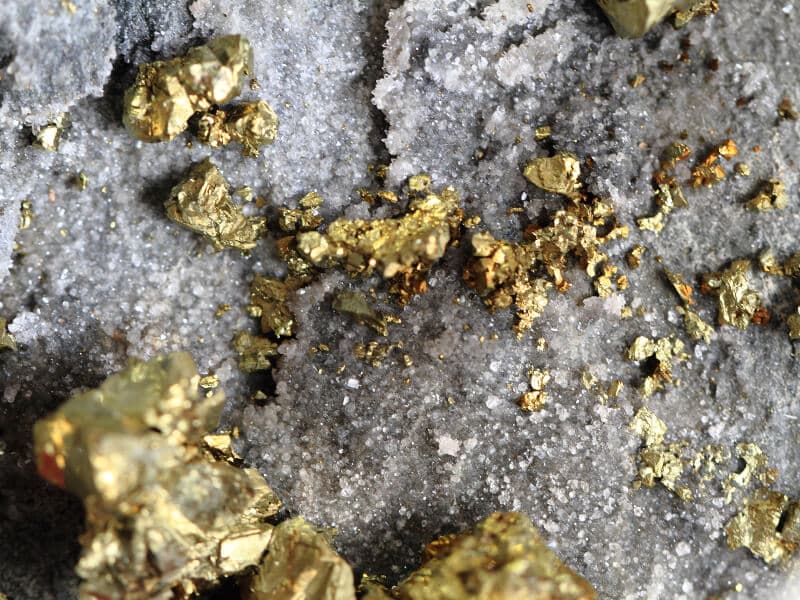Gold has captivated humans for centuries with its sparkling allure and intrinsic value. Gold has always been prized and coveted from ancient civilizations to modern society. While the quest for this precious metal may have changed over time, one thing has remained constant – the need for efficient methods of extracting gold from ore. Extracting gold from ore is a complex process that requires precision and expertise. We primarily aim to gold extraction methods from quartz veins, sulfide ores and polymetallic gold-bearing ores.

Extraction Gold from quartz vein gold ore
Quartz vein gold has been a valuable natural resource prized for centuries. Its alluring allure and scarcity make it a highly sought-after metal in the jewelry and investment industries. However, extracting gold from quartz vein gold ore is a meticulous process that requires careful planning and execution.
1. Cyanide gold extraction includes crushing, leaching, filtering, adsorption, elution, etc.
- The first step in the method is crushing the quartz into small pieces. This can be done using a jaw crusher or a mortar and pestle. After the quartz is crushed, it is mixed with water to form a slurry.
- Next, cyanide is added to the slurry to dissolve the gold particles. This process is called leaching. The slurry is then filtered to separate the liquid from the solid material. At this stage, activated carbon is introduced into the solution to absorb the dissolved gold.
- The final step in extraction from quartz vein gold ore involves elution or removal of adsorbed gold particles from the activated carbon. This is done by passing a cyanide solution over the carbon, which displaces and collects any remaining traces of gold. This solution is then treated with heat or chemicals to extract pure gold, which can be refined and used for various purposes.
The method relies on the difference in density between the gold particles and the surrounding rock. Water flow or centrifugal force can separate heavier gold particles from lighter material.
Regardless of the method chosen to extract gold from quartz vein ore, it is important to ensure that sustainable mining practices are followed. Long-term use of harmful chemicals such as cyanide can adversely affect ecosystems and human health. Low-toxic gold leaching reagents can be used instead of cyanide reagents for cyanidation gold extraction.
Extract gold from sulphide-containing ores
Flotation separation, the extraction of gold from sulfide gold ores, is a widely used and efficient technique in the mining industry. The process involves a chemical reaction between air bubbles and sulfide ore particles, causing the air bubbles to attach to these particles. As a result, these particles become buoyant and rise to the surface of the flotation cell, where they can be collected and further processed to extract gold.
The main advantage of using this method is that it can efficiently recover gold from low-grade or refractory ores, which are challenging to process using traditional methods. Additionally, flotation offers flexibility in choosing reagents and optimizing conditions to maximize gold recovery. This makes it an attractive option for small-scale miners with limited resources, as it provides a cost-effective method of extracting valuable gold from deposits. Flotation offers a viable solution for extracting small amounts of sulfide gold ores as it can efficiently recover valuable metals even from low-grade or refractory ores.
Extract gold from polymetallic gold ores
In addition to gold, such ores include copper, lead, zinc, tungsten, and antimony. This gold ore contains large sulfides (10%–20%). In addition to pyrite, natural gold is closely related to minerals such as copper and lead. The grain size of native gold is relatively coarse, but the grain size varies widely and unevenly with the mining depth. Beneficiation methods for extracting gold from polymetallic ores can vary depending on factors such as the mineralogy of the ore, the presence of other metals, and the desired end product. Generally speaking, the beneficiation methods of polymetallic gold ore include gravity separation, flotation, cyanidation and amalgamation,etc.
- Gravity separation is often used as an initial step to separate heavy minerals such as gold from lighter gangue minerals. The method relies on density differences between particles to separate them based on their specific gravity.
- Flotation efficiently separates valuable minerals by selectively attaching certain materials to air bubbles while leaving others behind.
- Cyanidation involves treating the ore with a sodium cyanide solution, which reacts with gold to form soluble complexes that can be recovered by further processing. Amalgamation, which uses mercury and gold particles to form an amalgam, is often used in small-scale mining operations.
This type of ore is generally processed by flotation, which concentrates the gold in the non-ferrous ore concentrate and then recovers the gold during the smelting process. Gold can be obtained by cyanidation from gold-bearing concentrates produced by the flotation of sulfide minerals in mines.
The gold extraction process mainly depends on the chemical composition of the gold ore, the mineral composition, the gold particle size of the gold, and the requirements of the finished product. Gravity separation, flotation, magnetic separation, cyanidation, these different extraction methods can maximize gold recovery. Whether you are a small miner or a large mining company, choosing the suitable mineral extraction methods and equipment from JXSC can significantly achieve the best beneficiation results. Contact us to get more process details and mining equipment latest price!